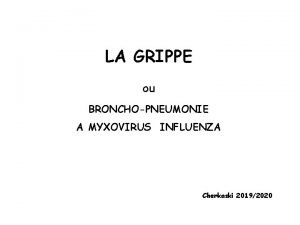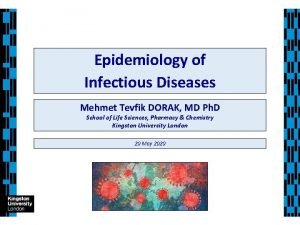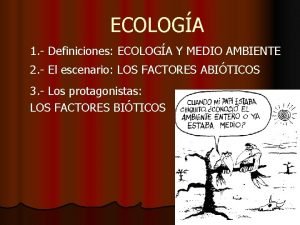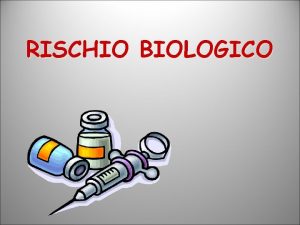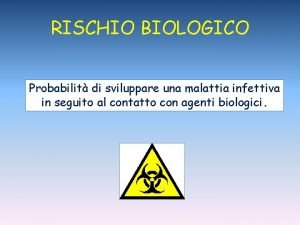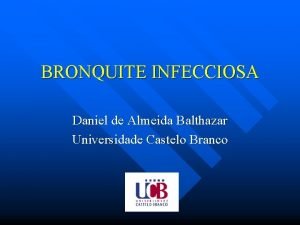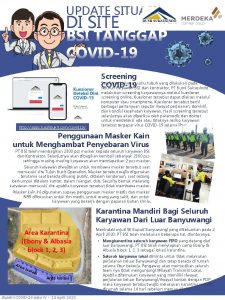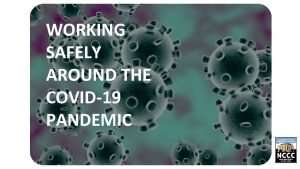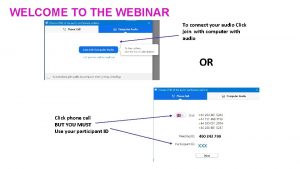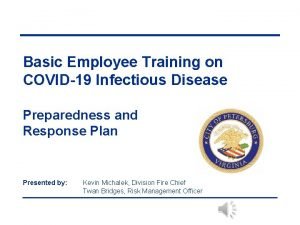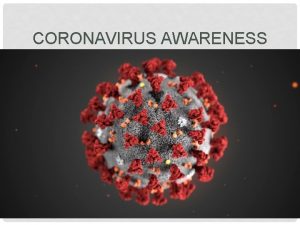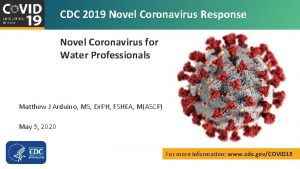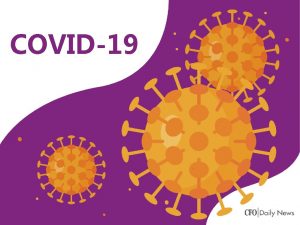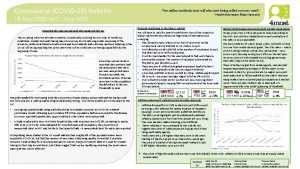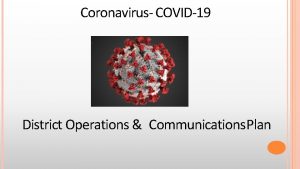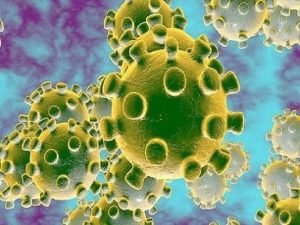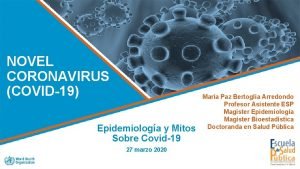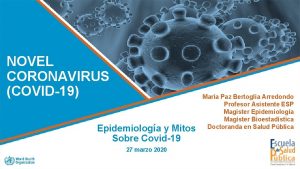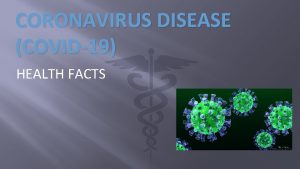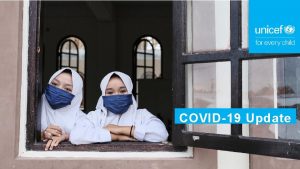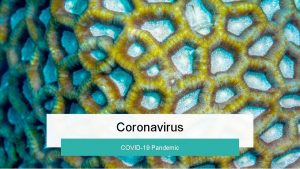2019 Novel Coronavirus Disease COVID19 Update Rappahannock Area
















- Slides: 16

2019 Novel Coronavirus Disease (COVID-19) Update Rappahannock Area Health District March 2, 2020

What is COVID-19? COVID-19 is a respiratory illness in humans caused by a new (novel) coronavirus Coronaviruses are a large family of viruses Symptoms of new virus can include: • Fever • Cough • Shortness of breath Most (80%) cases not severe Severe cases (20%) can cause pneumonia, respiratory failure, need for ICU care and death Symptoms may appear 2 -14 days after exposure to the virus

COVID-19 Cases in the United States 69 confirmed & presumptive cases among U. S. residents as of Feb 29, 2020 • • • 13 travel-related cases 9 person-to-person spread in U. S. 47 among individuals repatriated to the United States: • • 3 residents tested positive in Wuhan City 44 individuals aboard the Diamond Princess Cruise Ship tested positive • One PRESUMPTIVE death (not confirmed) from COVID-19 in United States • One death of a U. S. citizen in Wuhan, China • No cases of COVID-19 in Virginia

How is Coronavirus spread? Person-to-person spread thought to occur via respiratory droplets produced when a person coughs or sneezes • Droplets land on the mouth or nose of the person nearby or inhaled into the lungs • Currently unknown if a person can become infected by touching a surface or object that is contaminated with the virus – WHO feels risk is low • Research on when peak infectivity occurs is ongoing

• For 2019 novel coronavirus infection, please note this is a preliminary figure. Based on small number of patients in China. This could change in the future. • As of 2/27/2020, the confirmed case death rate is around 2. 3% • By comparison, CDC estimates that since 2010, seasonal influenza has resulted in 140, 000 – 810, 000 hospitalizations per year and 12, 000 – 61, 000 deaths per year

Public Health Response: Prevention and Treatment Currently no vaccine to prevent 2019 -n. Co. V infection No specific treatment for COVID -19 = supportive care Therefore, prevention is paramount. Standard infection control measures = wash hands, cover cough, stay home if ill, clean surfaces

Public Health Response: Non-pharmaceutical interventions (NPIs) Personal: • Personal protective measures you can take every day, and personal protective measures reserved for pandemics Community: • Social distancing measures designed to keep people who are sick away from others Environmental • Environmental cleaning measures

Non-pharmaceutical interventions (NPIs) Personal: • Stay home when you are sick (Stay home for at least 24 hours after being fever-free without the use of fever-reducing medications) – everyday use and pandemic measure • Respiratory etiquette = cover cough or sneeze – into a tissue or your sleeve. Wash hands or use hand sanitizer right after. An everyday use and pandemic measure • Hand hygiene = wash hands with soap and water frequently or use alcohol-based hand sanitizer. An everyday use and pandemic measure • Avoid touching your eyes, nose, or mouth – an everyday use or pandemic measure • Consider voluntary home quarantine of household members who have been exposed to someone they live with who is sick. This is a possible pandemic measure. Duration of quarantine would need to be determined. For pandemic influenza, would be one incubation period of virus. • Possible use of face masks (surgical mask) by ill persons. A possible pandemic measure • CDC does not generally recommend use of face masks by well people

Non-pharmaceutical interventions (NPIs) Community: • Preemptive coordinated school closures. Includes all types of schools = daycare, K-12 and colleges/universities. This is possible for more severe pandemic use. • Have a plan in place in the event of the need for school closures • Consider using internet-based teleschooling to continue education • Social distancing measures: Have a telework plan in place if physical workplace closure is advised. Businesses can replace in-person meetings with video or telephone conferences and increase teleworking options. • Communities may need to modify, postpone, or cancel mass gatherings. Another social distancing measure. • Healthcare providers may consider increasing telehealth services and delaying elective surgery in the event of sustained community transmission Environmental Cleaning: • Clean and disinfect frequently, particularly high touch items. An everyday use and pandemic measure.

Public Health Response: Coronavirus Screening/Testing Traveler screening at 11 airports: • • • John F. Kennedy, New York Chicago O’Hare, Illinois San Francisco, California Seattle - Tacoma, Washington Daniel K. Inouye, Hawaii Los Angeles, California Hartsfield – Jackson, Atlanta Washington - Dulles, Virginia Newark Liberty, New Jersey Dallas - Fort Worth, Texas Detroit, Michigan • Asking about symptoms of illness (fever, cough, shortness of breath), or exposure to person with COVID-19. Giving information about COVID-19


Public Health Response: Risk Assessment for Returning Travelers • Phone interview with local health department staff • Depending on risk assessment conclusions, VDH may advise: • Self-isolation = for symptomatic people • Self-quarantine = for ASYMPTOMATIC people • Monitor for symptoms on Daily Temperature Monitoring Log • Most returning travelers fall into asymptomatic, “medium risk” category: • • Returned from travel to mainland China (i. e. not Wuhan City) Have no symptoms of illness Require self-quarantine at home with public health supervision Must monitor their temp twice daily until end of the 14 day monitoring period

U. S. Public Health Response Summary • • Federal, state and local responses Entry screening at 11 U. S. airports CDC travel advisories issued for multiple countries (see https: //wwwnc. cdc. gov/travel/notices) Diagnostic test developed – Virginia state public health lab will do testing at some point in future Ongoing research on therapeutics Vaccine development underway Non-pharmaceutical Interventions (NPIs) Information and guidance • CDC website (www. cdc. gov/coronavirus) • VDH website (www. vdh. virginia. gov/coronavirus)

VDH and Rappahannock Area Health District Responses • VDH Coordinating with CDC and other states • RAHD coordinating with healthcare systems and providers for early case detection and infection control • Guidance from CDC, VDH, and state public health lab • RAHD: Person Under Investigation case management; contact tracing and monitoring • VDH and RAHD: Preparing for potential of further spread in U. S. • Working under Incident Command System (ICS) • VDH and RAHD: Education and information = press releases, letters, conference calls (www. vdh. virginia. gov/coronavirus) • VDH and RAHD targeted education • Healthcare providers – letters from Health Commissioner and RAHD • Educational institutions – VDH guidance on website • Local emergency managers - letter, conference call

Final Thoughts and Important Links to Information • Rapidly evolving situation • Case counts in U. S. will grow over the coming days and weeks • Public health guidance will change as more information learned • At this time, overall risk to U. S. general public considered low – may change • Vigilance, frequent communication, and coordination btw healthcare and public health are critical • More to learn about virus, transmission factors, risks for infection, and the disease itself • Promote flu and respiratory infection prevention • Updates will be communicated via: • Press releases, letters, etc. • www. vdh. virginia. gov/coronavirus • https: //www. cdc. gov/coronavirus/2019 -ncov/index. html • https: //www. who. int/health-topics/coronavirus

Thank You! Contact information for Rappahannock Area Health District staff: Brooke Rossheim, M. D. , M. P. H. District Director brooke. rossheim@vdh. virginia. gov Direct office: 540 -322 -5930 Nicole Sullivan District Epidemiologist nicole. sullivan@vdh. virginia. gov Cell: 540 -290 -2426 Wendi Lane Local Health Emergency Coordinator Office: 540 -322 -5940 Cell: 540 -940 -5486 wendi. lane@vdh. virginia. gov
 Labaran rappahannock
Labaran rappahannock Is an alternative of log based recovery.
Is an alternative of log based recovery. Scissurite coronavirus
Scissurite coronavirus Relazione finale funzione strumentale orientamento
Relazione finale funzione strumentale orientamento Mehmet tevfik dorak
Mehmet tevfik dorak 3 abioticos
3 abioticos Rischio biologico coronavirus | titolo x d.lgs. 81/08
Rischio biologico coronavirus | titolo x d.lgs. 81/08 Allegato xlvi del d.lgs. 81/08 coronavirus
Allegato xlvi del d.lgs. 81/08 coronavirus Bronquite coronavirus
Bronquite coronavirus Http//apps.tujuhbukit.com/covid19
Http//apps.tujuhbukit.com/covid19 Do if you covid19
Do if you covid19 Covid19 athome rapid what know
Covid19 athome rapid what know What do if test positive covid19
What do if test positive covid19 Vaksin covid19
Vaksin covid19 Bharathi viswanathan
Bharathi viswanathan Routing area update
Routing area update Vdot work area protection manual
Vdot work area protection manual


